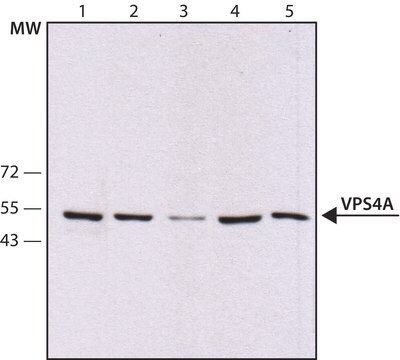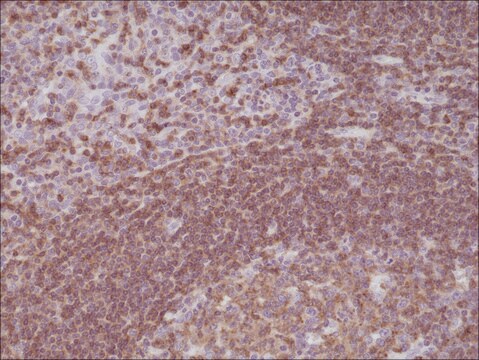ABS1646
Anti-VPS4A (UT289)
serum, from rabbit
Synonym(s):
Vacuolar protein sorting-associated protein 4A, Protein SKD2, SKD1-homolog, Vacuolar protein sorting factor 4A, Vacuolar sorting protein 4, VPS4A
About This Item
Recommended Products
biological source
rabbit
Quality Level
antibody form
serum
antibody product type
primary antibodies
clone
polyclonal
species reactivity
human, mouse
technique(s)
immunocytochemistry: suitable
immunoprecipitation (IP): suitable
western blot: suitable
NCBI accession no.
UniProt accession no.
shipped in
ambient
target post-translational modification
unmodified
Gene Information
human ... VPS4A(27183)
mouse ... Vps4A(116733)
General description
Specificity
Immunogen
Application
Immunoprecipitation Analysis: A representative lot immunoprecipited EGFP-VPS4A fusion together with CHMP5-Myc and Myc-LIP5 exogenously expressed in HEK293T cells. CHMP5-Myc with L4D mutation and Myc-LIP5 with M64A, W147D, or Y278A mutation failed to co-immunoprecipitate with VPS4A (Skalicky, J.J., et al. (2012). J. Biol. Chem. 287(52):43910-43926).
Western Blotting Analysis: A representative lot detected both endogenous VPS4A and exogenously expressed EGFP-VPS4A fusion in HEK293T cell lysates as well as in Anti-Myc immunoprecipites from CHMP5-Myc or Myc-LIP5 expressing cells (Skalicky, J.J., et al. (2012). J. Biol. Chem. 287(52):43910-43926).
Western Blotting Analysis: A representative lot detected the VPS4A target band in lysate from untransfected, but not VPS4A shRNA-transfected, HeLa cells (Morita, E., et al. (2010). Proc. Natl. Acad. Sci. U.S.A. 107(29):12889-12894).
Signaling
Quality
Western Blotting Analysis: A 1:1,000 dilution of this antiserum detected VPS4A in 10 µg of MCF-7 cell lysate.
Target description
Physical form
Storage and Stability
Handling Recommendations: Upon receipt and prior to removing the cap, centrifuge the vial and gently mix the solution. Aliquot into microcentrifuge tubes and store at -20°C. Avoid repeated freeze/thaw cycles, which may damage IgG and affect product performance.
Other Notes
Disclaimer
Not finding the right product?
Try our Product Selector Tool.
Storage Class Code
12 - Non Combustible Liquids
WGK
WGK 1
Certificates of Analysis (COA)
Search for Certificates of Analysis (COA) by entering the products Lot/Batch Number. Lot and Batch Numbers can be found on a product’s label following the words ‘Lot’ or ‘Batch’.
Already Own This Product?
Find documentation for the products that you have recently purchased in the Document Library.
Our team of scientists has experience in all areas of research including Life Science, Material Science, Chemical Synthesis, Chromatography, Analytical and many others.
Contact Technical Service






